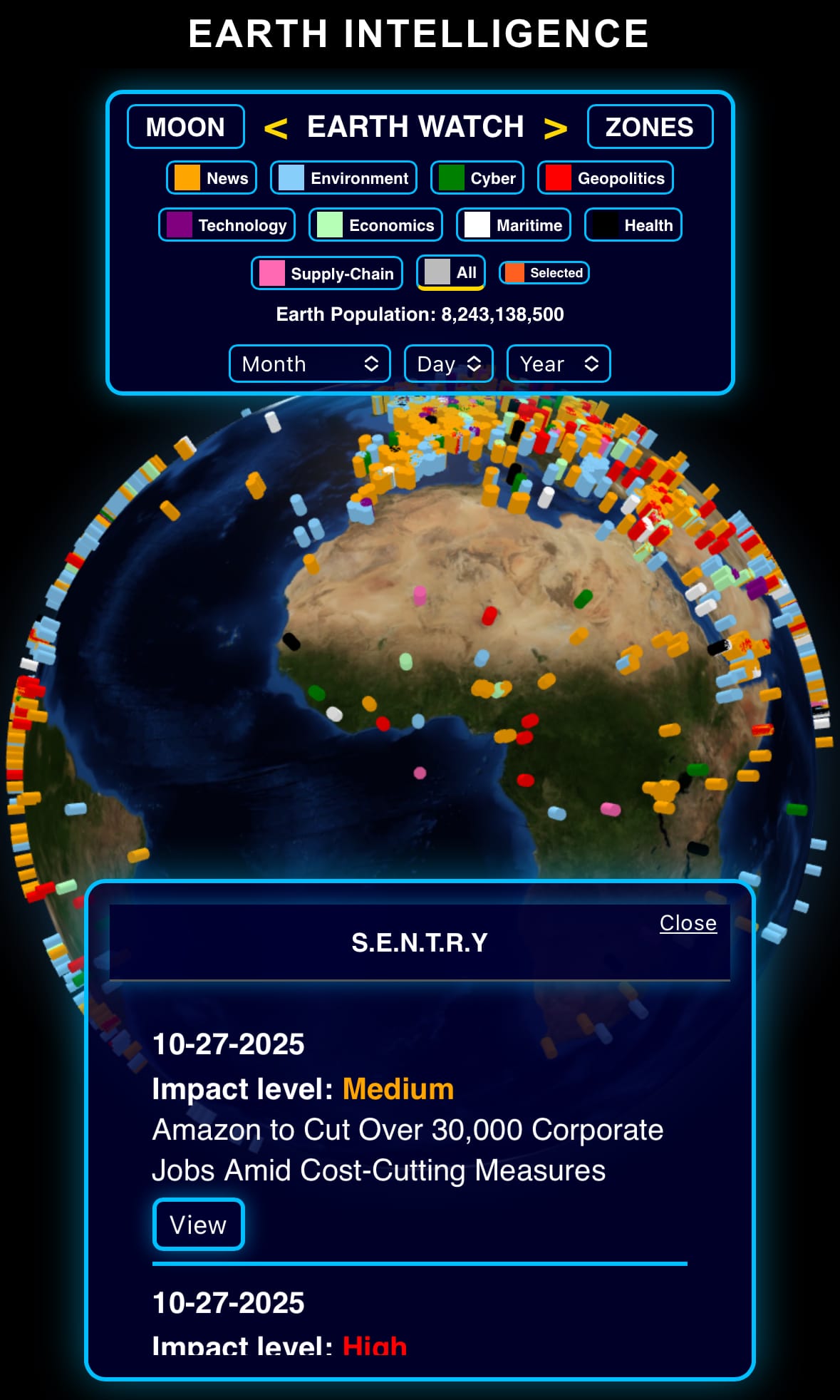Tuesday☕️

Economics & Markets:
- Yesterday’s U.S. stock market:

- Yesterday’s commodity market:

- Yesterday’s crypto market:

Geopolitics & Military Activity:
- On November 3, 2025, the Israel Defense Forces (IDF) conducted two separate airstrikes in southern Lebanon, eliminating two Hezbollah operatives within an hour, as part of ongoing operations to counter perceived threats. The first strike targeted a vehicle in the Nabatieh area, killing Muhammad Ali Hadid, identified by the IDF as a commander in Hezbollah's elite Radwan Force, who was allegedly involved in multiple attacks against Israel and recent efforts to rebuild terrorist infrastructure. The second strike, in the village of Ayta ash-Shab, targeted an unnamed operative accused of surveilling Israeli troops. These actions followed reports of Hezbollah attempting to rearm and violated understandings from a prior ceasefire, prompting no immediate casualties beyond the targets according to initial accounts.

- The strikes occur amid heightened tensions, with Israel's defense minister warning of potential escalation if Lebanon fails to enforce Hezbollah's disarmament under UN resolutions, and U.S. officials urging Beirut to negotiate directly to avoid further conflict. While the operations aim to prevent Hezbollah's resurgence in the region, they have drawn criticism for straining a fragile truce and risking civilian impacts in densely populated areas. Broader implications include potential setbacks to diplomatic efforts, increased regional instability involving allies like Iran, and calls for enhanced monitoring by international forces such as UNIFIL to verify compliance and de-escalate the situation.
Environment & Weather:
- On November 3, 2025, the Philippine Atmospheric, Geophysical and Astronomical Services Administration (PAGASA) issued heightened warnings for Typhoon Tino, internationally designated as Kalmaegi, which had intensified while moving toward the central Philippines. As of last night, the storm was located approximately 100 kilometers east-southeast of Guiuan in Eastern Samar, tracking westward at about 30 km/h (19 mph). Sustained winds have reached 150 km/h (93 mph) with gusts up to 205 km/h (127 mph), classifying it as the 20th tropical cyclone impacting the Philippines this year. This prompted the raising of Tropical Cyclone Wind Signal No. 4—the second-highest level—in areas including Eastern Samar, Leyte, Southern Leyte, and parts of Dinagat Islands, with landfall expected in Southern Leyte within hours.

- In response, authorities mandated evacuations for over 150,000 people in coastal and flood-prone zones, halted classes and government operations, canceled air and sea transport, and mobilized emergency teams across the Visayas region and sections of Mindanao. The storm's intensification has been attributed to favorable conditions such as elevated sea surface temperatures and minimal wind shear in the Philippine Sea, increasing threats of strong winds, rainfall over 200 mm in some areas, storm surges reaching 3 meters, and risks of flash flooding or landslides in elevated terrain. Forecasts indicate a slight weakening upon land interaction, followed by re-emergence into the West Philippine Sea and a potential path toward Vietnam.
Science & Technology:
- On November 3, 2025, OpenAI and Amazon Web Services (AWS) announced a multi-year strategic partnership valued at $38 billion to bolster OpenAI's AI development efforts, including training and scaling models such as ChatGPT. The agreement provides OpenAI with immediate access to AWS's cloud infrastructure, specialized hardware, and Nvidia graphics processing units for handling intensive AI workloads. Extending through at least 2027, the deal follows OpenAI's recent shift to a for-profit structure and represents a diversification from its prior heavy dependence on Microsoft Azure, with OpenAI committing substantial expenditures on AWS services to improve computing capacity amid rising demand for generative AI technologies.

- This collaboration reflects broader trends in the cloud computing industry, where providers are competing to support large-scale AI operations, potentially reducing OpenAI's risks from single-supplier reliance and supply chain issues in semiconductor availability. As global AI integration expands, the deal could reshape competitive landscapes for cloud services and encourage similar alliances across tech sectors.
Statistic:
- Largest public banking companies by market capitalization:
- 🇺🇸 JPMorgan Chase — $842.11B
- 🇺🇸 Bank of America — $392.56B
- 🇨🇳 Agricultural Bank of China — $380.32B
- 🇨🇳 ICBC — $362.09B
- 🇺🇸 Wells Fargo — $274.90B
- 🇨🇳 China Construction Bank — $265.15B
- 🇺🇸 Morgan Stanley — $260.36B
- 🇺🇸 Goldman Sachs — $242.56B
- 🇬🇧 HSBC — $242.27B
- 🇨🇳 Bank of China — $235.30B
- 🇨🇦 Royal Bank Of Canada — $208.53B
- 🇦🇺 Commonwealth Bank — $191.29B
- 🇮🇳 HDFC Bank — $187.08B
- 🇺🇸 Citigroup — $181.81B
- 🇯🇵 Mitsubishi UFJ Financial — $172.73B
- 🇺🇸 Charles Schwab — $169.08B
- 🇪🇸 Santander — $151.28B
- 🇨🇳 CM Bank — $147.31B
- 🇺🇸 Capital One — $140.93B
- 🇨🇦 Toronto Dominion Bank — $140.26B
- 🇨🇭 UBS — $118.61B
- 🇸🇬 DBS Group — $117.30B
- 🇪🇸 Banco Bilbao Vizcaya Argentaria — $114.66B
- 🇸🇦 Al Rajhi Bank — $113.83B
- 🇮🇹 Intesa Sanpaolo — $113.67B
History:
- Electronic warfare (EW) traces its roots back to World War I, when armies first began experimenting with radio communications and quickly realized that intercepting or jamming enemy signals could turn the tide of battle. By World War II, EW had become a decisive tool — radar detection and deception systems were developed to protect bombers and mislead anti-aircraft defenses, with Britain’s use of “Window” (chaff) and Germany’s early radar innovations marking key milestones. The Cold War then brought a massive leap forward: electronic intelligence (ELINT) and signals intelligence (SIGINT) became central to espionage, while the development of radar-guided missiles, stealth technologies, and countermeasures turned the electromagnetic spectrum into a full-scale battlefield.
- Today, electronic warfare has evolved into an intricate and autonomous domain, blending cyber capabilities, artificial intelligence, and real-time data analysis. Modern EW systems don’t just jam or deceive; they sense, decide, and strike within microseconds across land, sea, air, and space. Nations now deploy entire fleets of EW-capable drones and satellites capable of disrupting communications, GPS, and even weapon guidance systems. As digital infrastructure becomes the nervous system of modern militaries, EW sits at the intersection of traditional warfare and cyber conflict — a silent, invisible war where dominance depends on who controls the spectrum.
Image of the day:

Thanks for reading!
- EARTH INTELLIGENCE builds private intelligence systems for organizations — connecting their internal and external data with AI to create one interactive command center for real-time awareness, decision making, and predictions.
Earth is complicated, we make it simple.
- Click below if you’d like to view our free EARTH WATCH globe:


Click below to view our previous newsletters:

Support/Suggestions Email:
earthintelligence@earthintel.news




